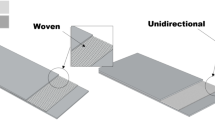Abstract
Fiber-metal-laminates (FML) provide a high variability in part properties and are often used to satisfy multiple component demands in aerospace applications. However, conventional use of hybrid laminates in the automotive sector is unrewarding due to high manufacturing costs and strongly restricted forming degrees. This paper presents an approach, which enables the manufacturing of laminate components with low bending radii for high volume applications. To separate the carbon fiber–reinforced polymers (CFRP) from the metal sheets, an elastomer layer was used, resulting in the omission of surface treatments for adhesion and corrosion prevention. The forming degrees presented in this work exceeded current approaches. Furthermore, the influence of the forming process on the mechanical properties was analyzed, thus ensuring the profitability of the presented approach for industrial applications.











Similar content being viewed by others
References
Sinmazçelik T, Avcu E, Bora M et al (2011) A review: fibre metal laminates, background, bonding types and applied test methods. Mater Des 32:3671–3685
Hinz S, Omoori T, Hojo M, Schulte K (2009) Damage characterisation of fibre metal laminates under interlaminar shear load. Compos A: Appl Sci Manuf 40(6–7):925–931. https://doi.org/10.1016/j.compositesa.2009.04.020
Takamatsu T, Matsumura T, Ogura N, Shimokawa T, Kakuta Y (1999) Fatigue crack growth properties of a GLARE3-5/4 fiber/metal laminate. Eng Fract Mech 63(3):253–272
Homan JJ (2006) Fatigue initiation in fibre metal laminates. Int J Fatigue 28(4):366–374
Laliberte JF, Poon C, Straznicky PV et al (2002) Post-impact fatigue damage growth in fiber-metal laminates. Int J Fatigue 24(2):249–256
Alderliesten RC, Hagenbeek M, Homan JJ, Hooijmeijer PA, de Vries TJ, Vermeeren CAJR (2003) Fatigue and damage tolerance of Glare. Appl Compos Mater 10(4):223–242. https://doi.org/10.1023/A:1025537818644
Vlot A, Gunnink JW (2001) Fibre metal laminates - an introduction. Springer Verlag Netherlands, Dordrecht
Vermeeren C (2003) An historic overview of the development of fibre metal laminates. Appl Compos Mater 10(4–5):189–205
Stoll M, Weidenmann KA (2017) Materials selection for a fiber-metal-laminate with elastomer interlayers. roceedings of the 21st international conference on composite materials, Xi’an, pp 3795–3801
Lin CT, Kao PW, Jen M-HR (1994) Thermal residual strains in carbon fibre-reinforced aluminium laminates. Composites (25):303–307
Müller B, Sinke J, Anisimov AG, Groves R (2015) Thermal strains in heated fiber metal laminates. In: Aggelis DG, Van Hemelrijck D (eds) Emerging technologies in non-destructive testing VI. CRC Press, London, pp 205–211
Wang W, Takao Y, Matsubara T (eds) (2007) Galvanic corrosion-resistant carbon fiber metal laminates. 16th International Conference on Composite Materials. Kyoto, Japan. 07. August 2007
Sarlin E, Hoikkanen M, Frisk L, Vuorinen J, Vippola M, Lepistö T (2014) Ageing of corrosion resistant steel/rubber/composite hybrid structures. Int J Adhes Adhes 49:26–32
Stoll M, Stemmer F, Ilinzeer S et al (eds) (2017) Optimization of corrosive properties of carbon fiber reinforced aluminum laminates due to integration of an elastomer interlayer. KEM 742: 287–293. https://doi.org/10.4028/www.scientific.net/KEM.742.287
Sarlin E, Hoikkanen M, Frisk L, Vuorinen J, Vippola M, Lepistö T (2014) Ageing of corrosion resistant steel/rubber/composite hybrid structures. Int J Adhes Adhes 49:26–32
Stoll M,Weidenmann KA (eds) (2016) The impact of environmental stress on the mechanical behavior of fiber-metal-laminates with elastomer interlayers (FMEL). Proceedings of the 17th European Conference on Composite Materials (ECCM17), München
Stoll M,Weidenmann KA (eds) Characterization of interface properties of fiber-metal-laminates (FML) with optimized interfaces. Euro Hybrid Materials and Structures. Kaiserslautern. 20-21 April 2016, vol 2016. Karlsruhe Institute of Technology (KIT), Institute of Applied Materials IAM-WK
Sessner V, Stoll M, Feuvrier A et al (eds) (2017) Determination of the damping characteristics of fiber-metal-elastomer laminates using piezo-indicated-loss-factor experiments. Trans Tech Publ
Sarlin E, Liu Y, Vippola M, Zogg M, Ermanni P, Vuorinen J, Lepistö T (2012) Vibration damping properties of steel/rubber/composite hybrid structures. Compos Struct 94(11):3327–3335
Sinke J (2003) Manufacturing of GLARE parts and structure. Appl Compos Mater 10(4/5):293–305. https://doi.org/10.1023/A:1025589230710
Fleischer J, Roth S, Sommer C (2016) Faser-Metall-Gummi-Hybridlaminate - Produktionsprozessentwicklung für ein neuartiges Materialsystem. ZWF 111(9):483–486
Roth S, Coutandin S, Fleischer J (2019) Material- and process characterization of fibre-metal-elastomer laminate components with high forming degrees. In: Dröder K, Vietor T (eds) Technologies for economical and functional lightweight design: conference proceedings 2018. Springer Vieweg, Berlin, Wiesbaden, pp 147–154
Vogelesang LB, Vlot A (2000) Development of fibre metal laminates for advanced aerospace structures. J Mater Process Technol 103(1):1–5. https://doi.org/10.1016/S0924-0136(00)00411-8
Datta J (2001) Aluminium-Werkstoff-Datenblätter, 3rd edn. Aluminium-Verlag, Düsseldorf
Stoll M (2018) Behavior of fiber-metal-elastomer-hybrid-laminates. Dissertation, Karlsruhe Institute of Technology (KIT), Institute of Applied Materials IAM-WK
Acknowledgments
The authors thank the Kraiburg Holding GmbH und Co. KG for providing the elastomer material in this study.
Funding
The research presented in this paper was kindly financed by the Baden-Württemberg Stiftungs project “Faser-Metall-Gummi-Hybridlaminate (FMGL) ein neuartiges, nachhaltiges Werkstoffkonzept für den Fahrzeugleichtbau”, support code MAT0012 of the research program “Rohstoff- und Materialeffzienz in der Produktion.”
Author information
Authors and Affiliations
Corresponding author
Additional information
Data availability
The raw/processed data required to reproduce these findings cannot be shared at this time due to technical or time limitations.
Publisher’s note
Springer Nature remains neutral with regard to jurisdictional claims in published maps and institutional affiliations.
Rights and permissions
About this article
Cite this article
Roth, S., Stoll, M., Weidenmann, K.A. et al. A new process route for the manufacturing of highly formed fiber-metal-laminates with elastomer interlayers (FMEL). Int J Adv Manuf Technol 104, 1293–1301 (2019). https://doi.org/10.1007/s00170-019-04103-4
Received:
Accepted:
Published:
Issue Date:
DOI: https://doi.org/10.1007/s00170-019-04103-4




